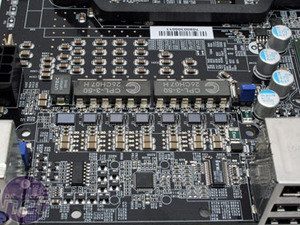Sapphire Pure CrossFireX PC-AM2RD790
February 15, 2008 | 08:27

Board Layout
The now “standard black” PCB plays as a base to many colours on the board – this is not typical LANParty attire of UV-adorned parts – Sapphire has customised the look to make it fit a more open free-for-all approach, with different colours merely differentiating the different parts.The one thing you notice is the simply massive heatsink used to cool the digital PWMs. This is at one end of a single chrome plated heatpipe running through the middle of the north bridge heatsink and down to the south bridge’s heatsink – both are much smaller than the PWM heatsink and are aluminium. A good thing to note here is that all of the heatsinks are thankfully screwed down to ensure the best possible contact.

What gets me is that there are clearly slots and screw holes for extra hardware to attach (DFI trans-piper), yet nothing is supplied – during testing, we found that a 125W AMD Athlon 64 X2 6000+ under load would cause the large heatsink to heat up quite a bit – while our first board was unstable without extra airflow, the second board we used seemed a lot happier and a lot cooler.
There’s no additional fan supplied in the box like the one that Asus includes with all of its heatpiped boards (should you need it) and given the single orientation of the AM2+ socket there’s no guarantee that it will get any airflow from the CPU socket.
Under the big aluminium heatsink, the seven-phase digital PWM and array of ceramic capacitors pushes the CPU socket further right than usual, meaning the memory is pushed out towards the edge as well. This condenses the ATX power socket and some power regulation components but it’s all fitted very well – the only issue is that the CPU socket is quite close to the DIMMs, but that’s necessary because of the integrated memory controller in the CPU.


In fact, while the general layout is a little different than what you’d normally expect, it is still very good – we found no conflicts and there’s plenty of space where there needs to be. The PCI-Express slots have ample room underneath for dual height cards; the memory slots don’t conflict with them either and the SATA and IDE ports are angled at 90 degrees to the board where necessary – it all works.
Feature-wise, there are three PCI-Express 2.0 slots, as opposed to four for CrossFireX – this gives you some choice in the market at least – do you go for three more powerful dual height cards, or four that fit single slots? That is, depending on whether you have enough space for the bottom one in the black slot, at the very base of your case. The PCI-Express x4 slot is unfortunately not open-ended, but that’s nothing a Dremel wouldn’t quickly fix. The three PCI slots should keep many people happy too, and the big bonus here is that you can use two of them even when there are three dual height graphics cards installed. Despite there being no explicit PCI-Express x1 slots, the x16 and x4 slots will double up if you have x1 peripheral cards.
Sapphire includes a couple extra SATA ports from a Silicon Image controller, so we have a total of six on this board compared to most other boards four. Although with the new SB700 south bridge offering six native SATA right around the corner, I’d keep in mind that there are possible new revisions – Foxconn has already shown off 790FX boards featuring the SB700 south bridge.
As is usual now, we get all solid state capacitors and as is specific to DFI-based hardware there are even little aluminium heatsinks dotted about the place to cool individual mosfets for the memory and north bridge – both of these get a single phase.
What does nark me is the use of floppy power connectors instead of Molex plugs – not just one but two. Most PSUs we review now have at most one or sometimes none at all. Yes, I see that they are smaller but they are also easily confused with 4-pin fan headers which are also white and about the same size. What I do like though is the standard two digit LED POST readout and onboard power and reset switches – a small, quite common addition maybe, but an invaluable one nonetheless.

MSI MPG Velox 100R Chassis Review
October 14 2021 | 15:04










Want to comment? Please log in.